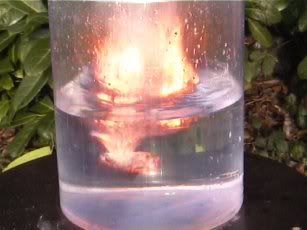Justifying What We Teach in HS Chemistry
Elemental sodium burning in water
This topic was one I dove into on the National Science Teacher Association's (NSTA) chemistry listserv. I think I honed my appreciation for how most discussions are best not had on a listserv, as well as my need to be more diplomatic when I address writers who I perceive as either patronizing or poor thinkers - well, let's say possibly good thinkers with poor writing skills. Actually more likely than not I shouldn't even bother being more diplomatic but rather just keep my thoughts to myself and turn to the blog for airing whatever's on my mind. Unfortunately after all was said and done I didn't really come to any definitive answer to the question that presents itself in the title to this blog, i.e. how do we justify what we teach in the high school chemistry classroom?
Ok, so what brings me to this topic? The issue that started the discussion on the NSTA chemistry listserv dealt with whether group 1 metals (the "group" refers to the element's place on the periodic table, with group 1 elements occupying the first column) should be used in high school chemistry class demonstrations. The specific group 1 metals used for these demos are most often sodium and potassium (you're possibly saying to yourself that these aren't metals, they don't look anything like metals, but based on how you chemically define metals these are quintessential metals), with sodium being the most frequently used element.
Group 1 elements are very reactive, they'll all easily react with water and to varying degrees with air. Sodium is highly reactive and to give you some idea of what it takes to just store sodium we can go to the Flinn Scientific Company's (Flinn is easily one of the most used scientific supply companies in the U.S., used by science instructors to meet a broad range of needs in every scientific discipline; their catalog is ubiquitous in science departments) recommendation for this:
Sodium metal is best stored in a glass container covered in dry mineral oil. The bottle should be labeled appropriately. The bottle should then be placed in a heavy-duty plastic bag and sealed with a twist-tie. Should the container be broken, the sodium metal will still be contained in the plastic bag. The container and bag should be placed into a metal paint can, surrounded by kitty litter and sealed. The outside of the metal can should also be labeled appropriately.
So clearly the metal itself is dangerous to work with and more so to store. The latter consideration, i.e. storage, is most important. This site and its accompanying movie, Sodium in water, gives you an excellent idea of the hazards of sodium (note: clicking on this link takes you to a write-up describing how to do a sodium in water demo; reading this gives you an idea of what is involved in such a demonstration. Click on the "movie" hyperlink in the upper left hand corner of the page and you'll be taken to a movie which shows you the sodium in water demo. You'll have to click on the play button to move through the slide presentation to get through to the movie.)
Doing the demo, if it's done correctly, is not especially hazardous, but the metal itself is dangerously explosive, will react with just about anything with no stimulus (i.e. no fire, electrical spark, nothing other than being exposed to the ambient environment), and if stored improperly it lends itself to pilferage (students LOVE anything that explodes, one of the reasons often given for such demos) or being inadvertently exposed to something which would cause the metal to explode or combust. While all high school chemical storage rooms have potentially dangerous chemicals in them, few if any are as spontaneously combustible such as sodium is. Stories abound, both documented and apocryphal, concerning mis-used or accidentally reacted sodium.
So why should high school teachers be allowed to have such chemicals in their possession? In some states and school districts they're not allowed to. But why at all anywhere? Keep in mind that any high school chemistry teacher can get these metals, but there is absolutely no guarantee that a teacher is trained to do a demo using them or is trained, or supervised in
anyway, with regard to how to properly store them. Is having the metals in storage and doing an in-person demo (clearly a movie demonstrating the reaction is easy to access) worth the potential risks?
The answer to this question seems to come down to the following two things:
1. A sodium demo clearly shows how reactive this family of elements are in a dramatic way that makes an impression on students, thereby helping them to understand better appreciate the principles behind such reactivity.
2. It's entertaining to the students. Blogger's comment: Every high school teacher alive will tell you that there are two things that students live for in a chemistry class, anything that explodes, followed by anything that burns in a spectacular fashion.
So on the one hand we have something with inherent learning potential which many insist is best done in person, i.e. a movie just doesn't have the same impact. On the other hand there's possible learning potential (in fact there's no reason to think that reasons 1 and 2 are or should be exclusive of one another), but the focus is more on grabbing the students' attention, and possibly doing something that entertains the instructor as well. In the latter case a sodium demo becomes the chemistry teacher's equivalent of the English teacher showing Franco Zeffirelli's Romeo and Juliet, with the girls entertained by lovely young people rebelling against authority for love, and the boys putting up with it all to ogle Olivia Hussey's well-developed, but alas not quite bared, bosom.
Flinn, the same company referenced above, sells kits (for $24.95, pre-shipping - Flinn also sells a video showing sodium reactivity for about $35; while it may seem that I am, I am NOT shilling for Flinn, honest) which are designed to minimize the risks associated with a group 1 demo. Given that the company is certainly to be sensitive to the possibility of being sued it goes to great lengths to ensure that the quantity of sodium sent out is small and that what's sent is going to be used in the demo safely if the instructor follows the demo instructions. This sort of convenience and focus on safety comes at a price, and most chemistry teachers who've any experience with handling chemicals know that they can normally get something much cheaper than what they'd have to pay a company like Flinn if they're willing to go out and buy the stuff individually and design their own demos. Be assured, there are teachers out there right now who are doing this.
The question came down to what's already stated, "Why should chemistry teachers be allowed to do this? Who's saying that the inherent risks with doing such a demo is outweighed by any learning objective, which ostensibly can be met by a movie? If such demonstrations are indeed sound from a learning perspective, and that learning outweighs the risk, should all chemistry teachers be expected to use something akin to the Flinn demo packs which minimizes possible risks?"
This question leads to a much larger one, one that I indirectly addressed in an earlier post,
What Should We Be Teaching In HS Chemistry? What specific guidelines should we be using to establish what's taught in the high school chemistry classroom? It's clear that high school teachers are out of synch with college teachers, and a similar case can be made for being out of
synch with employers as well, but why, and how do we justify it? I'll try to address this in part II.

1 Comments:
BG,
Actually I think the demo is manageable given the right restrictions. The fact is that by and large there are no restrictions, with regard to actually performing the demo or with how much of this stuff one can store in the chemical store room. That, I believe, needs to be addressed and settled, i.e. the storage and demo parameter issues, before you can do this in a way that's reasonably safe.
Your call to attract students with demos such as these is a common statement from a lot of teachers, and your take on American students is one that many share in the secondary school community. My problem with this is I'm inclined to think that we're getting ourselves more in the entertainment business than we are in the teaching business. We're doing poorly with recruitment of students into the sciences, not a single study in the last few years supports anything other than that we're failing to get students interested. This, "Let's entertainment them with fire, smoke, and explosions" trend in the sciences has been afoot for a while now and it doesn't seem to be doing it. American kids are also stacking up poorly against their international counterparts when it comes to science and math; something's just not right here.
So I find myself seriously questioning that this is indeed a worthwhile investment of time, effort, and expense when maybe what's called for is more rigor in the curriculum and a more focused discipline. I'm not talking about going back to the days of slapping kids on the knuckles with rulers, but rather that demos and gee whiz stuff not be nearly the big concern that it seems to be, and that we come up with better tools to help kids understand, appreciation, and master the tools that come with doing science.
Post a Comment
<< Home